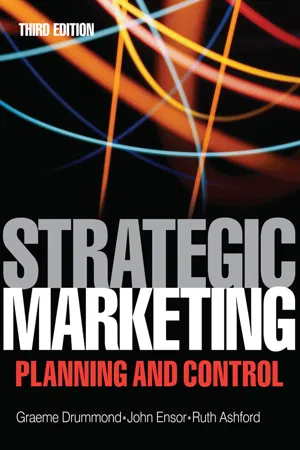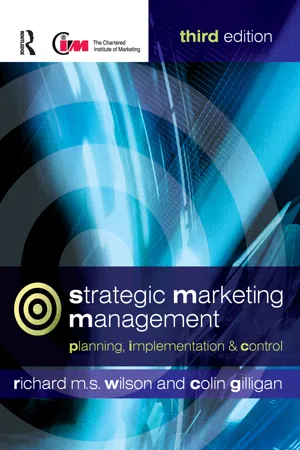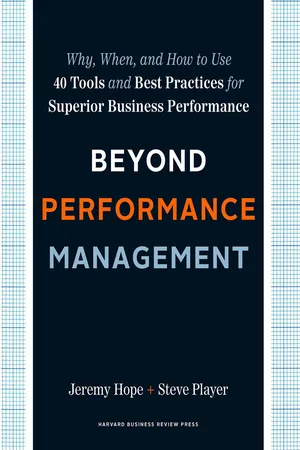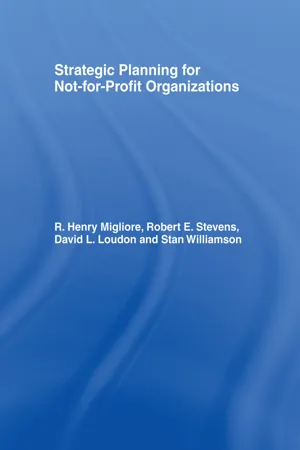Business
Corporate Mission and Objectives
A corporate mission outlines the purpose and values of a company, serving as a guiding principle for its operations and decision-making. Objectives are specific, measurable goals that a company aims to achieve in alignment with its mission. Together, the mission and objectives provide a framework for strategic planning and help to define the company's direction and priorities.
Written by Perlego with AI-assistance
Related key terms
12 Key excerpts on "Corporate Mission and Objectives"
- eBook - ePub
- Adrian Payne, Malcolm McDonald(Authors)
- 2012(Publication Date)
- Routledge(Publisher)
In this chapter, we have looked at the first phase of the planning process, which we called the ‘strategic context’. It consists of two steps: formulating the corporate mission and setting corporate objectives and strategies. We went on to define the mission statement and to discuss its strategic value. Companies who had trouble in formulating their mission did so partly from ignorance and partly because they fell into some common traps — they made it too broad or too narrow, were unclear about the audience to which it was addressed, were confused about the nature of their business, the mission was not sufficiently unique and representative of the company, or it focused on the service rather than on the customers.Being clear about what the mission means is one thing, formulating it so that it is both realistic and acceptable is something else. We looked at two participative methods for arriving at a mission which had organizational value. Methods such as these not only utilized organizational creativity, but also initiated the communication pro- cess which is so essential if the mission is to impact on the hearts and minds of managers and staff.Corporate objectives and strategies are designed to make the mission come alive. We saw that the organization also had to align its objectives and strategies towards meeting customer needs and that, sometimes, this could have profound implications for the corporate culture. Although objectives could be qualitative or quantitative in nature, the latter must be capable of being measured, because they remove ambiguity. However, we did see that there was a role for qualitative objectives in terms of providing a broad backdrop to the organization.The success of the whole marketing planning process is determined to a large extent by the way these first two steps are tackled. That is why it should be done very thoroughly. No marketing plan can be written properly until these elements of the overall corporate strategy are in place. That they should be in place is the responsibility of top management, not the marketing department. - eBook - ePub
Marketing Plans for Services
A Complete Guide
- Malcolm McDonald, Pennie Frow, Adrian Payne(Authors)
- 2011(Publication Date)
- Wiley(Publisher)
Figure 5.3 both focus on many of the key issues we consider should be addressed in a mission statement for such a firm. It also illustrates the need to develop corporate objectives which are highly integrated with the mission statement. Without a strong linkage, which provides a means of measuring whether the mission can be achieved, much of the potential value of a mission can be dissipated. The relationship between corporate objectives and mission has been well summed up by the chairman and CEO of General Mills:We would agree that, unless our mission statement is backed up with specific objectives and strategies, the words become meaningless, but I also believe that our objectives and strategies are far more likely to be acted upon where there exists a prior statement of belief (i.e. a mission) from which specific plans and actions flow.We return to this issue later in this chapter when, in Figure 5.12 , we look at a simple framework for undertaking a consistency check between a mission and the corporate objectives.Figure 5.12 Corporate objectives and mission need to be tightly integratedMission statements can be an empty statement on a piece of paper, or can reflect and underpin fundamental values of an organization in pursuit of its strategy.Levels of mission statementJust as companies have different levels of objectives, ranging from strategic objectives through to tactical objectives and action plans, a service organization should consider to what extent it should develop mission or purpose statements at lower levels of the organization. Cranfield University in the UK has, for example, an overall University Mission Statement, while each of the university’s schools (such as Aerospace, Computer Science, Management, etc.) has its own mission statement. Also, within the School of Management, for example, each group, such as the Marketing Group, has its own mission statement, all contributing to this university’s outstanding success. - eBook - ePub
- Tom Craig, David Campbell(Authors)
- 2012(Publication Date)
- Routledge(Publisher)
Organisational and Business Objectives
DOI: 10.4324/9780080454603-2Learning Objectives
After studying this chapter, students should be able to describe:- mission, vision and values of an organisation;
- the purpose of an organisation’s mission statement;
- the complex nature of defining business goals and objectives;
- the most important business objective;
- the stakeholders;
- the view that stakeholder coalitions determine the business objectives;
- the view that an organisation’s principals essentially determine the business objectives.
2.1 Vision
This is an aspirational view of the desired state of the organisation at a point in the future. The timeframe is dependent on the nature of the organisation and its environment but a typical vision would be set for 3–5 years ahead and reviewed annually in line with actual results and changing circumstances. The vision is in effect a statement of strategic intent that serves to focus the energies of the organisation management towards the setting and achievement of specific goals and objectives. Its aspirational nature means that it is consistently revised, as each set of goals are achieved, and further stretching future situations are established.2.2 Mission
The mission of an organisation is a general expression of the overall purpose of the organisation or, more simply, a broad description of the business it is in – its raison d’être. It broadly defines the scope and boundaries of the organisation, which should be in line with the expectations and values of major stakeholders.Mission Statements
Some organisations find it helpful to provide a concise and clear written statement of their broad objectives. Whilst such statements are called different names, most find the term mission statement - eBook - ePub
- Graeme Drummond, John Ensor, Ruth Ashford(Authors)
- 2010(Publication Date)
- Routledge(Publisher)
PART 2 Formulation of Strategy
Passage contains an image
Strategic intent
DOI: 10.4324/9780080561219-7About this chapterAn organisation has to have key objectives that define the aims that any strategy attempts to fulfil, this is the realm of strategic intent. This chapter explores the issues surrounding an organisation's mission, goals and objectives. The hierarchy of objectives in an organisation is discussed, as is the use of the balanced scorecard approach.■ Introduction
Before an organisation starts to make judgements about how it is going to compete, fundamental decisions about the organisation's overall method of operation and the areas it wishes to serve have to be articulated. A conscious statement of the primary direction and purpose of the organisation has to be the key foundation upon which objectives and strategy are based. This rationale behind the company's existence usually comes in the form of a mission statement and is meant to act as a guiding light to all personnel within the organisation.■ Mission
The mission of the organisation is the unique purpose that distinguishes it from other companies and defines the boundaries of its operations. The mission statement is a proclamation of the organisation's primary objective that encapsulates its core values. The organisation's aims and aspirations are the result of a series of influences (see Figure 7.1 ).Influences on an organisation's mission and objectives ( Source: Adapted from Johnson and Scholes, 1999 )There are four major sources of influence acting upon the core meaning behind an organisation's existence. Johnson and Scholes (1999) refer to these as:- Corporate governance
- eBook - ePub
Corporate Purpose
Why It Matters More Than Strategy
- Shankar Basu(Author)
- 2017(Publication Date)
- Routledge(Publisher)
30 According to them, the first component of a company’s strategy is a sense of purpose. This purpose in turn shapes the company’s business concept, which is the second component of a company’s strategy. The third component of the strategy is the company’s economic objectives, which is derived from the purpose and is given a focus by the business concept. Such economic objectives are the company’s targets for profit, growth, market share, and rates of return. These authors believe that in most outstanding companies financial objectives are a means to achieving higher order, objectives. Such a purpose is founded in the context of a company’s corporate culture and basic values. Badaracco and Ellsworth are proponents of such belief, and they write:Just as people have many needs and goals, so do organizations. In most outstanding companies, financial objectives are viewed as a means of achieving higher, more fundamentally important, non-financial purposes. These purposes embody the company’s basic values and define the distinctive contribution it seeks to make to its owners, its employees, its customers, the communities in which it does business, and its other constituents, even its nation.31Conceptually this is similar to the understanding of purpose and its relation to key objectives as used in this book.Some business authors such as Andrew Campbell and Laura L. Nash believe that individuals in organizations are searching for a sense of purpose and a sense of identity, something that they call a “sense of mission”. According to them, individuals want more from their organization than pay, security, and the opportunity to develop their skills. They want a cause that is personally satisfying. These writers argue that mission is strategy-based and also culture-based. Accordingly, a mission exists when strategy and cultural values are mutually supportive.Campbell and Nash incorporate purpose, strategy, values, and behavioral standards into corporate mission. Purpose is defined through answering “Why do I exist and, for whose benefit are all the efforts being made?” Strategy is defined by what business the company will compete in and the distinctive competence or competitive advantage that the company has or plans to have. Values are the beliefs and moral principles that lie behind a company’s culture. Finally, standards and behavior are the culmination of purpose, strategy and values that establish the norm of action and behavior guidelines, policy and procedures that help the employees to decide what to do daily.32 - eBook - ePub
Market Segmentation
How to Do It and How to Profit from It
- Malcolm McDonald(Author)
- 2012(Publication Date)
- Wiley(Publisher)
corporate objective , which describes a desired destination or result. Most often this is expressed in terms of profit, since profit is the means of satisfying shareholders or owners, and because it is the one universally accepted criterion by which efficiency can be evaluated, which will, in turn, lead to efficient resource allocation, economic and technological progressiveness and stability. How it is to be achieved is a strategy. In a sense, this means that the only true objective of a company is, by definition, what is stated in the corporate plan as being the principal purpose of its existence.- - - - - - - - - -Definition:The only true objective of a company is, by definition, what is stated in the corporate plan as being the principal purpose of its existence.A corporate objective describes a desired destination or result. Most often this is expressed in terms of profit. - - - - - - - - - -This means that stated desires, such as to expand segment share, to create a new image, to achieve an x % increase in sales, and so on, are in fact strategies at the corporate - eBook - ePub
- Richard M.S. Wilson, Colin Gilligan(Authors)
- 2012(Publication Date)
- Routledge(Publisher)
This process of moving from the general to the specific should lead to a set of objectives that are not just attainable within any budgetary or other constraints that exist, but that are also compatible with environmental conditions as well as organizational strengths and weaknesses. It follows from this that the process of setting objectives should form what is often referred to as an internally consistent and mutually reinforcing hierarchy. As an illustration of this, if we assume that corporate management is concerned first and foremost with, say, long-term profits and growth, it is these objectives that provide the framework within which the more detailed subset of operational objectives, including market expansion and product-specific increases in sales and share, are developed. Taken together, these then contribute to the achievement of the overall corporate objectives.It is these operational objectives that are the principal concern of those in the level below corporate management. Below this, managers are concerned with objectives that are defined even more specifically, such as creating awareness of a new product, increasing levels of distribution, and so on. This hierarchy points in turn to the interrelationship, and in some cases the confusion, that exists between corporate objectives and marketing objectives. The distinction between the two is an important one and is discussed at a later stage in this chapter. However, as a prelude to this, and indeed to the process of objectives setting, there is a need for the strategist to decide upon the business mission. We therefore begin this chapter with a discussion of the role and purpose of planning as the background against which we can more realistically examine approaches to the development of the mission statement and, subsequently, corporate and marketing objectives (see Illustration 7.1).Illustration 7.1 Objectives, strategies and plansThe interrelationships between objectives, strategies and plans have been spelled out by Davidson (1987a , p. 122), who, in discussing BMW’s recovery efforts in Germany in the 1960s, made the following comments.BMW was on the verge of bankruptcy. It was producing motorcycles for a dwindling market, and making a poor return on its bubble cars and six-cylinder saloons. A takeover bid by Daimler-Benz, the makers of Mercedes, was narrowly avoided, and the group was rescued by a Bavarian investment group. - eBook - ePub
- Lidia Varbanova(Author)
- 2013(Publication Date)
- Routledge(Publisher)
Vision, Mission and ObjectivesLEARNING OBJECTIVESUpon completing this chapter you should be able to:- Describe the elements that make up an organisation’s identity.
- Understand and explain why defining an organisation’s mission (purpose) and vision is so important.
- Understand the three-dimensional framework for formulating objectives.
- Elaborate how organisational objectives can be set up using the SMART approach.
- Analyse the mission statements and objectives of diverse arts organisations.
- Elaborate the section of the strategic plan related to the mission, vision and goals of an arts organisation.
- Connect the theory on the strategic-thinking phase of the strategic management with practical case studies.
1. THE IMPORTANCE OF ORGANISATIONAL IDENTITY
The start-up phase of the strategic management process is strategic thinking, which includes formulation of the organisation’s mission statement (raison d’être, or the organisation’s purpose), vision and long-term goals.There is no agreed formula or common recipe on what would be a good mission statement as it is situation specific and different for every individual case. A mission statement is a unique, specific and positive message. The majority of authors place the elaboration of the mission and vision at the start of the strategic planning process, as it gives the general vector of the strategic objectives, operational activities and tasks. The following are several selected opinions of authors on strategies, in both the business and the nonprofit sectors, on what mission means and what would be the components of a mission statement:- Peter Drucker (1974)1
- eBook - ePub
- Richard M.S. Wilson(Author)
- 2010(Publication Date)
- Routledge(Publisher)
This process of moving from the general to the specific should lead to a set of objectives that are not just attainable within any budgetary or other constraints that exist, but that are also compatible with environmental conditions as well as organizational strengths and weaknesses. It follows from this that the process of setting objectives should form what is often referred to as an internally consistent and mutually reinforcing hierarchy. As an illustration of this, if we assume that corporate management is concerned first and foremost with, say, long-term profits and growth, it is these objectives that provide the framework within which the more detailed subset of operational objectives, including market expansion and product-specific increases in sales and share, are developed. Taken together, these then contribute to the achievement of the overall corporate objectives.It is these operational objectives that are the principal concern of those in the level below corporate management. Below this, managers are concerned with objectives that are defined even more specifically, such as creating awareness of a new product, increasing levels of distribution, and so on. This hierarchy points in turn to the interrelationship, and in some cases the confusion, that exists between corporate objectives and marketing objectives. The distinction between the two is an important one and is discussed at a later stage in this chapter. However, as a prelude to this, and indeed to the process of objectives setting, there is a need for the strategist to decide upon the business mission. We therefore begin this chapter with a discussion of the role and purpose of planning as the background against which we can more realistically examine approaches to the development of the mission statement and, subsequently, corporate and marketing objectives.8.3 The Purpose Of Planning
In discussing the nature and role of the planning process, Jackson (1975 ) comments that:Planning attempts to control the factors which affect the outcome of decisions; actions are guided so that success is more likely to be achieved. To plan is to decide what to do before doing it. Like methods, plans can be specially made to fit circumstances or they can be ready made for regular use in recurrent and familiar situations. In other words, a methodical approach can be custom built or ready made according to the nature of the problems involved. - eBook - ePub
Beyond Performance Management
Why, When, and How to Use 40 Tools and Best Practices for Superior Business Performance
- Jeremy Hope, Steve Player(Authors)
- 2012(Publication Date)
- Harvard Business Review Press(Publisher)
Part IStrategic Planning
Passage contains an image
1
MISSION STATEMENTS
What is this practice and how effective is it?
Mission statements have become popular in recent years as managers look to build a high-performance culture. The trouble is that most focus on lofty goals and meaningless words rather than inspiring people with a compelling “reason for being” and core values that build their emotional commitment. Consequently, despite the time and effort involved, people end up ignoring most of them. We will look at how the best organizations deal with these problems and inspire their people.Alternative names and related topics: corporate governance; business ethics; emotional commitmentHow an organization defines its purpose and defines and articulates its goals influences how its people think, behave, and act in any given situation. Many organizations have focused their purpose and goals on making money or maximizing shareholder value rather than building great businesses and satisfying stakeholders, including employees, customers, and the wider community. The shareholder value model is rooted in traditional economic thinking. The model assumes that individuals are self-interested, rational decision makers driven by economic goals, and that economic relationships—with employees, suppliers, customers, and external partners—are governed by binding contracts. In the industrial age, most people didn’t need to understand their company’s purpose; they simply did what was specified on their job descriptions and what their bosses told them to do.In this model, the senior executive officers are agents of the owners, who act as stewards for the owners’ capital and are hired and paid to invest it wisely and grow its value over successive years. If they succeed, they are well rewarded, but if they fail, their jobs are on the line. Most large corporations have mission statements filled with words such as “shareholder value,” “customer service,” and “product quality.” And of course every chairman’s report pays homage to the firm’s employees, who are usually “the company’s greatest assets.” But despite pandering to other stakeholders, most executive teams know that it is increasing shareholder value that will keep them in their jobs. - Robert E Stevens, David L Loudon, R Henry Migliore, Stanley G Williamson(Authors)
- 2013(Publication Date)
- Routledge(Publisher)
2 Objectives can be defined as clear, concise written statements outlining what is to be accomplished in key areas in a certain time period, in objectively measurable terms. Objectives can be classified as routine, problem solving, innovative, team, personal, and budget performance.Objectives can be set at upper organizational levels in key result areas such as growth, finances, physical resources, staff development and attitudes. They are also needed in sub-units, departments, or divisions of an organization. Most important, all organizational objectives must be consistent. Thus, a department’s objectives should lead to accomplishing the overall organization’s goals.Objectives serve two fundamental purposes. First, they serve as a road map. Objectives are the results desired upon completion of the planning period. In the absence of objectives, no sense of direction can be attained in decision making. In planning, objectives answer one of the basic questions posed in the planning process: Where do we want to go? These objectives become the focal point for strategy decisions.Another basic purpose served by objectives is in the evaluation of performance. The objectives in the strategic plan become the yardsticks used to evaluate performance. As will be pointed out later, it is impossible to evaluate performance without some standard by which results can be compared. The objectives become the standards for evaluating performance because they are the statement of results desired by the planner.Objectives have sometimes been called the neglected area of management. In many situations there is a failure to set objectives, or the objectives which are set forth are unsound and therefore lose much of their effectiveness. To counteract this, a management tool called management by objectives (MBO) was developed. It emphasizes the need for setting objectives as a basic managerial process, prpviding coordination of activities at all levels of the organization.- eBook - ePub
Evaluating Public Relations
A Guide to Planning, Research and Measurement
- Tom Watson, Paul Noble(Authors)
- 2014(Publication Date)
- Kogan Page(Publisher)
In much the same way that the term objective is frequently used without too much care, so there tends to be confusion with the associated (but not overlapping) concepts of strategy and tactics. While the objective is the end-point that the programme, campaign or activity is attempting to reach, the strategy is the overall approach to be used in pursuance of reaching that end-point: not to be confused with tactics, the particular set of actions required in order to implement the strategy.FIGURE 8.2 Goals and objectivesManagement by objectivesIn a general business context, the term objective is most commonly associated with the concept of management by objectives (MBO). Indeed, this is nothing more than common sense in public relations where we have already established that objectives play a key role before, during and after the implementation of a communications programme, and we have established that public relations is a management process.This reinforces the central role that objectives can, and frequently do, play in modern management thinking. As Kotler et al (2009: 105) explain, while most business units pursue a range of objectives, for an MBO system to work, the business unit’s various objectives must meet four criteria:- they must be arranged hierarchically, from the least to the most important;
- objectives should be quantitative whenever possible;
- goals should be realistic: goals should arise from an analysis of the business unit’s opportunities and strengths, not from wishful thinking;
- objectives must be consistent: it is not possible to maximize both sales and profits simultaneously.
These exhortations will be echoed in much of the discussion of public relations objectives outlined below. For instance, a hierarchy of objectives implies the linking of public relations objectives, directly or indirectly, with organizational objectives. Taking another example, the encouragement for objectives to be quantified is a mantra oft repeated in a public relations context. In terms of being realistic, public relations objectives need to be communications objectives. Finally, realism also points towards being realistic about the effects sought. Public relations practitioners too often fall into the trap of promising/assuming over-optimistic results from their efforts. This may breed euphoria in the short term, but certainly disappointment and disillusionment follow in the medium to long term.
Index pages curate the most relevant extracts from our library of academic textbooks. They’ve been created using an in-house natural language model (NLM), each adding context and meaning to key research topics.











